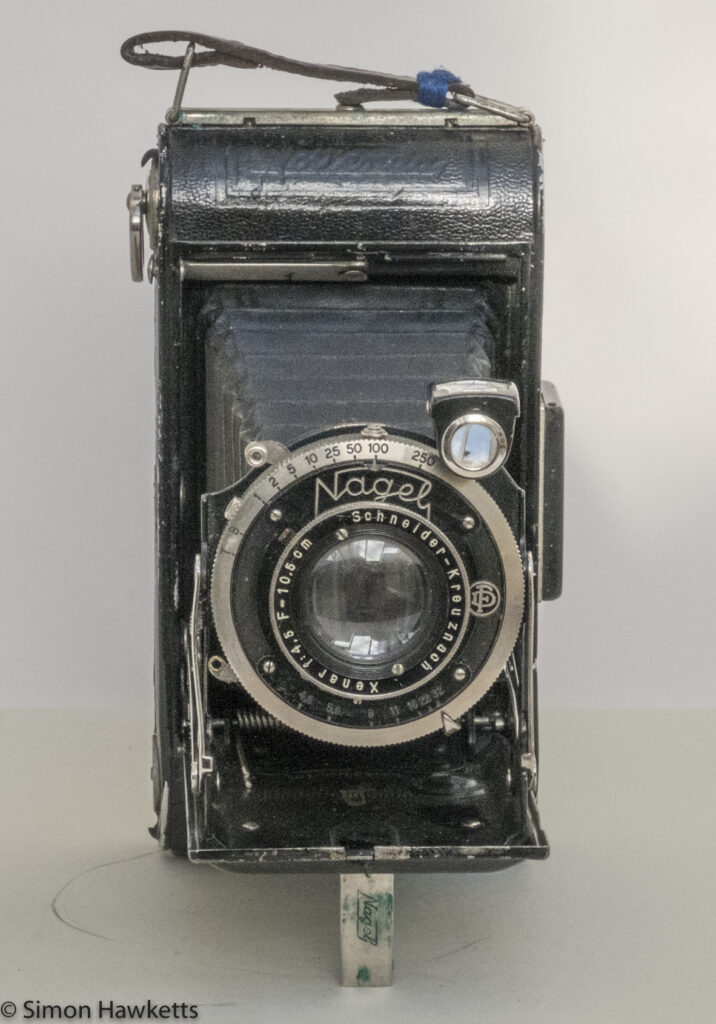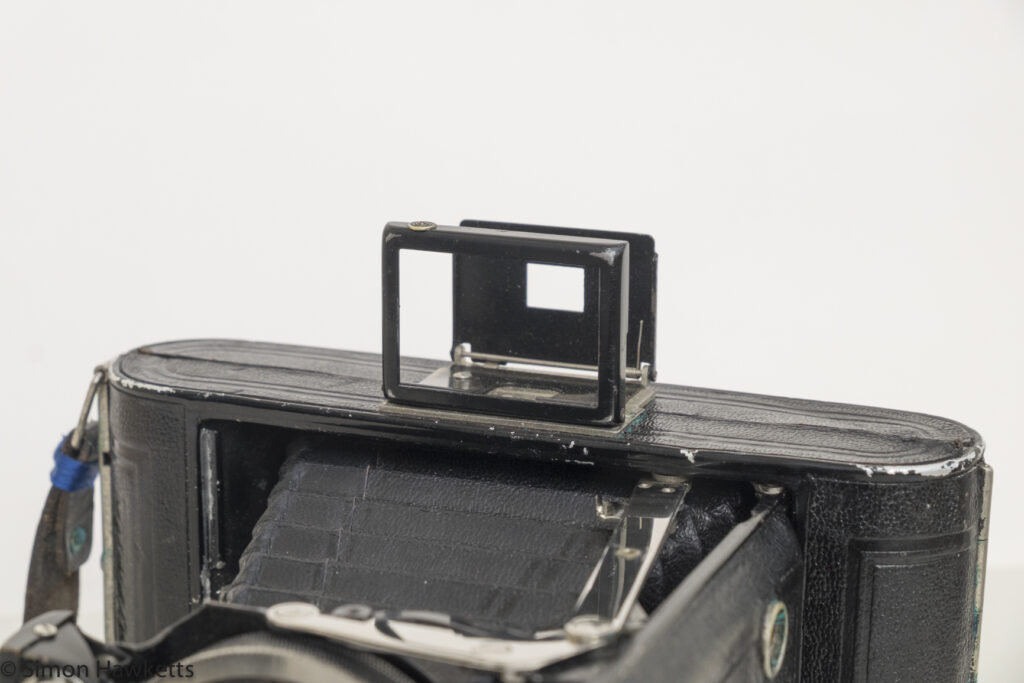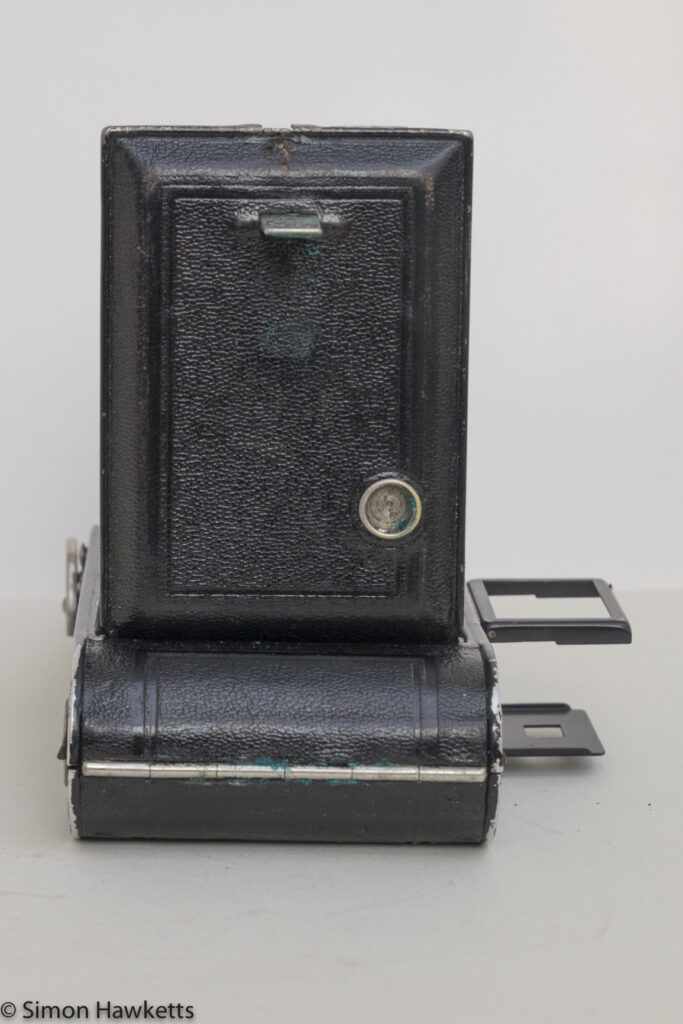Nagel Vollenda folding camera
This is a pictorial post about the Nagel Vollenda folding camera which was made by Dr. August Nagel in, probably, the 1930s.
Nagel Vollenda Images












My Nagel Vollenda camera
I picked this camera up from eBay UK for a total of £15 including postage.
I initially became interested in it simply because it is a folding camera and I wanted to increase the ‘folders’ section of my collection. However, once I looked at the pictures of it on the sellers’ ad, one factor made the camera much more appealing – in the picture of the back of the camera I could see the number 5 in the small red window showing there was a film still fitted.
The seller described the camera as having a couple of problems, namely the lens door catch is broken, and the leather hand strap is held together with a piece of blue string, but I thought it likely that those issues could be repaired, so I placed a bid in the last few seconds and picked it up for the £15 I said above.
When it turned up a couple of days later, I found it is in reasonable condition considering its age (which is probably about 80 or more years old), but that the seller was accurate when he said the front door will not latch shut. There is also some green corrosion on the front support, some of the case material is peeling off and the shutter release has lost its terminal.
The good news however is that the fitted compur shutter is working well and although there is some dust in the lens there doesn’t appear to be any fungus. Also, the bellows, which are a common failure point on cameras this old, are flexible and light tight.
The first thing I did with the camera, before I got too carried away with trying it out and certainly before I opened the back, was wind on and remove the roll of Kodacolour X film which was still inside. I’ll develop that using Stand Development and hopefully find at least a few old pictures on it!
Nagel Vollenda Description
I did a little research on the Nagel company because Nagel is not a common make of camera in the UK.
The founder of the company which manufactured this camera was Dr August Nagel, who was also one of the founding members of the Zeiss Ikon company, which he left to form his own company in 1928. That new company was successful in building several cameras, including the Vollenda, and after being taken over by Kodak in 1932, became the manufacturer of several Kodak cameras including the Retina series.
When I first bought this camera, I didn’t actually know the model was Vollenda – I just knew it was a Nagel because that is written on the front of the lens. It took a few internet image searches to find the same model and discover the model was Vollenda, although once I’d discovered that, I found the name is actually inscribed in the covering on the front by the handle.
As with most medium format folding cameras, the design is very simple, being really just a shutter & lens assembly held the right distance from the film by the collapsible bellows. In the case of the Nagel Vollenda, the shutter is a Compur 8 speed unit and the lens is a Schneider-Kreuznach 105 mm f/4.5. That lens and shutter combination suggests to me that this camera is probably capable of some quite nice results, especially since the negative size produced is 6 cm x 9 cm, which is quite big.
To use the camera, the front lens assembly needs to be extended by opening the front cover and pulling the lens out until two locks click into place when the lens is correctly positioned. After the picture is taken, there are two release levers on the back of the mechanism which allow the lens to be pushed back into place. I always think the folding camera is a remarkably simple and effective design, allowing a camera which takes such big negatives to take up so little space.
For focusing, the camera has a rotating front lens element with a scale from infinity down to a little under 1 ft, although there is no focusing assistance in the form of a rangefinder. The distance had to be measured or estimated and manually applied, or, more likely, the aperture would be set to something like f/11 and allow the depth of field to keep everything sharp.
To compose the picture, there are two viewfinders. On the top of the camera is a simple frame which lifts and can be used at eye-level. Mounted on the shutter is a waist level finder which can be rotated to work in either landscape or portrait orientation, although it needs to be moved back to portrait for the bellows to close. Although the waist level finder is a nice addition, I have to say I find it difficult to see anything in it – possibly the copy on my camera is simply too old, and the silvering has degraded.

To set the exposure, there is the Compur shutter and aperture arrangement, which offers a high level of control and shows that this camera was certainly a serious photographic tool at the time it was made. Many cameras at the time would have been simple box cameras with a single shutter speed and perhaps two aperture settings, so the 8 speeds + B + T and the 7 aperture stops makes a really impressive arrangement.
The shutter cocking and release is all mechanical and controlled by the photographer. There is a lever at the top of the shutter to cock it and another lever at the bottom to fire it, and no coupling to the film advance. When you use a camera like this you need to have a method set to either fire and wind or wind and fire and remember it, so you don’t get missed frames or double exposures!
When the shutter is set to either of the longer settings, i.e. Bulb or Time, it doesn’t need to be cocked but operates straight from the shutter release. For anyone not aware of the Bulb and Time settings, they operate by just opening the shutter when the shutter release is pressed. In the case of Bulb the shutter opens until the release is, well, released, and for Time the shutter opens on one press of the release and then closes on a second press.
Nagel Vollenda Specifications
- Nagel Vollenda medium format folding camera
- Made in Germany in about 1930
- 8 exposures on a standard 120 film
- Compur shutter offering 1sec to 1/250sec + B & T
- Cable release socket
- 105mm f/4.5 Schneider-Kreuznach lens
- Aperture f/4.5 to f/32
- Multiblade (round) aperture
- Frame viewfinder and rotatable waist level finder
- Manual cocking and firing of shutter
- Lens hood foot acts as table stand
- Tripod bush on base and lens hood
- Shutter Ser No: 2595363
- Manual available on-line here.
Discover more from Everything Vintage
Subscribe to get the latest posts sent to your email.






A great backgrounder on this camera. Thanks ???